- Home
- Laurie R. King
Laurie R. King's Sherlock Holmes Page 2
Laurie R. King's Sherlock Holmes Read online
Page 2
On a considerably less exalted level, thus did Laurie King adopt the character of Sherlock Holmes, to see what happened when that Victorian consulting detective, that brilliant mind, those all-seeing eyes, that impatience with lesser mortals and obsession with the scientific method, found himself faced with a very different world, and with a person whose skills rivaled his own.
And so Mary Russell was born, and this younger and considerably womanlier Holmes led me into unexpected paths.
Early on, I discovered Sherlockian Higher Criticism, that elaborate doffing of the hat to the Ways of Oxbridge (for the first players of The Game were theologians and academics from Oxford and Cambridge, and they spoke the language they knew.i) Grammatical analysis, chronological nitpicking, textual exegesis, and reductio ad absurdum are the rule, with abstruse areas of expertise applied despite the lack of any rational justification.
Now, given that I originally trained as an academic before I left the True Path to stray into the realm of fiction, and given that I write a character who is by education and inclination a scholar, I feel that in addressing an august group such as the present one, I have the right—I have the responsibility—to venture into the realm of scholarship. With Russell looking over my shoulder, I can no other.
With clear recognition that I am seriously outclassed here when it comes to skill at The Game, which Dorothy Sayers famously said one must play it with the seriousness of a county cricket match at Lord’s, nonetheless I dare to offer to you my own small contribution to Sherlockian scholarship, the King theory of the jezail bullet, in which we shall re-examine the much-debated but never settled topic of Dr. Watson’s oddly migratory war wound.
In the interest of full disclosure, I will add that I am only in part responsible for the King Theory. My husband, Noel, who is perhaps the least likely person in the world to have contributed to the realm of Sherlockian higher criticism, solved the problem in an off-handed remark approximately two seconds after I told him about the conundrum. Such is the insight permitted a man who never reads fiction.
But Noel is a generous sort and doesn’t object to my horning in on his earth-shaking revelation, ruthlessly taking all the credit.
Dr. Watson’s war wound is no doubt much-trodden ground with my present audience, so much so that it brings to mind Granny and the art of egg-sucking. Nonetheless, we must begin with a brief review of the primary source material.
In the opening pages of A Study in Scarlet, Dr. Watson describes how he trained as a medic in the British Army, was sent to Afghanistan, seconded to the Berkshires, and sent to the front, where, in the best tradition of young officers newly arrived—what in Vietnam came to be known as FNGs—he was promptly shot down. “I was struck on the shoulder by a Jezail bullet, which shattered the bone and grazed the subclavian artery.”
However, in The Sign of the Four he describes how “I sat nursing my wounded leg. I had had a Jezail bullet through it some time before, and though it did not prevent me from walking it ached wearily at every change of the weather.” Later, Holmes refers to Watson’s limp and, specifically, to Watson’s damaged Achilles tendon. In “The Adventure of the Noble Bachelor”, Watson speaks again of “the Jezail bullet which I had brought back in one of my limbs.”
In Sherlockian scholarship, inevitably, this contradiction in wounds is seized with considerable enthusiasm. There appear to be two main approaches to its solution. In the first, the duality of wounds is prosaically attributed to two separate bullets, one in the leg and one in the shoulder. And one is forced to admit that, if this were the case, it would not be the only occasion in the Canon in which the good doctor exhibited a degree of inexactitude.
In the other approach, one which is trodden by a considerably more enterprising group of scholars, our Higher Critics labor to shape a narrative in which the doctor’s solitary bullet might be accepted at face value. In his New Annotated Sherlock Holmes, our friend Les Klinger gives an excellent review of these theories, beginning with that of Peter Brain, who posits a situation in which Watson was shot from below while squatting at the top of a cliff and relieving himself—which I’m very certain is absolutely not cricket and must be contrary to the Geneva Convention—the dastardly bullet thus passing through thigh to shoulder and beyond.
Personally I would wonder if this does not introduce the hitherto unknown Jezail Boomeranging Bullet into our conundrum, for the round to have passed through Watson’s leg, then shoulder, only to return to lodge in the leg again, remaining there to plague him years later in Baker Street.
Another scenario by which one bullet might make two wounds is found in the original, Baring-Gould, edition of The Annotated Sherlock Holmes, where the author cites Dr. J. W. Sovine’s suggestion that
…the Jezail bullet struck Dr. Watson just above and missing the left clavicle, while he was bent over a wounded patient; that it grazed the left sub-clavian artery and shattered the left scapula, then ricocheted, passing to the left and downward, describing a spiral curve deep under the skin of the chest and abdomen, thence downward into the left leg, coming to rest in the calf muscles.
Baring-Gould draws on Mr. R. M. McLaren’s opinion that “the wound sustained by Watson in Afghanistan was an extraordinary one, the bullet having entered his shoulder and emerged from his leg,” and concludes that these views might be summed up as the One Singular Wound at Maiwand school.
Singular, indeed.
There are, inevitably, a thousand related theories: That Watson actually died at Maiwand and his orderly, Murray, took his place, hence explaining the errors and absentmindedness of the stories. That the wound was not in the leg but in “a part of his anatomy which his modesty and delicacy forbade his mentioning,” thus also explaining why, in three marriages, Watson never had children. (It might also explain why he had three marriages, come to that.) I particularly liked the theory put forth by Dr. Selvairs in no less a place than the Journal of the Royal Society of Medicine that the grazing of the sub-clavian artery had led to “the unfortunate cerebral result of a post-traumatic subclavian steal,” which I assume means brain damage. This theory would explain a number of problems in Watson’s writings.
However, lest we follow the paths constructed by historians and find ourselves along the shaky cliff-top on which Watson so precariously balanced, let us pause for a moment to apply a dose of academic rigor to the problem. As a famous Rhodes Scholar is known to have said, “it depends on what the meaning of the word ‘is’ is.” In addressing the problem of the jezail bullet, we need to begin with the most basic of questions: First, What is the meaning of jezail? And second, What is meant by bullet?
Again, both are addressed by the honorable Mr. Baring-Gould, when he refers to Dr. Roland Hammond’s article with the rather quease-inducing title, “The Surgeon Probes Dr. Watson’s Wound.” To quote in full:
The rifle or musket from which this bullet is fired is long and heavy with a crooked stock and used with a forked rest. It is of native manufacture and is patterned after the British Lee-Enfield rifle. Bannerman’s complete catalogue of military weapons does not list the Jezail rifle as such, although numerous India matchlock guns are featured. The bullets are often slugs made from nails or odd scraps of metal including silver, and may produce infected wounds.
(Parenthetically, I will note that Dr. Hammond would have benefited by a modern knowledge of the Internet, where one finds any number of jezail rifles for sale, at what seems to me a reasonable price—although granted, all cost considerably more than the “ten-rupee jezail” that knocks down the young officer with his “two thousand pounds of education” in Kipling’s poem concerning the Arithmetic of the Frontier. Then again, there aren’t many officers these days whose education only cost two thousand pounds, either.)
The jezail is a muzzle-loader nearly as tall as a man, similar to the American Kentucky rifle, and was every bit as deadly in the hands of the Asian frontiersmen as his American counterpart. Unlike the pray-and-spray techniques of the modern semi-au
tomatic rifle, the jezail requires a steady hand. And unlike the barrage of rounds that come out of the modern gun, the jezail shoots one round, propelled by a dose of powder, hammered down the barrel, a shot at a time.
In his notes to the Oxford A Study in Scarlet, Owen Dudley Edwards describes that jezail round as “liable to cause infection in the wounds it made since its ingredients would be old nails, broken silver, etc assembled in archaic fashion.”
(Again parenthetically, when I left academic theology for the writing of detective fiction, leaving a life of God for a life of crime, I turned my back on the discipline of the footnote. One suspects the same of these two gentlemen, who fail to footnote their dependence on what a theologian might call here the Jezail Q Document, that source of the phrase “old nails and broken silver.”)
Let us not be distracted from our purpose—although you are no doubt beginning to wonder (another glass of wine, anyone?) what, precisely, is our purpose? It is a question I ask myself with great regularity, mostly when I reach the halfway point of a manuscript or, indeed, a lecture like this.
In another life, I might have come before you with footnotes and citations, but I am no longer an academic, I am a storyteller. My truths are those that are uncovered in a story’s unfolding, where facts and implications are inextricably intertwined.
In the craft of fiction, one submits one’s will to the progress of a story, writing a tale as it wishes to be written, and in this way, unlike the linear approach of the academic, larger truths may occasionally be glimpsed. Arthur Conan Doyle wrote his life of a consulting detective for a number of reasons, few of which are the same reasons why we read them.
When I quit academia, when I went cold turkey from the temptations of the library and started down the road to recovery, it took me some time to realize that an academic paper may not be the only way of commenting on a time or a place, or a person. It may not even be the best way. Therefore with your permission, I should like to present the King Theory of the jezail bullet not in a form of higher criticism, but in the form of a story.
* *
Picture, if you will, an early morning in the hill country of Afghanistan. The sky grows light here long before the sun reaches the folds of ground, for there are high mountains all around. The smoke of cook-fires lies heavy across the land, rising here and there as men by the thousands gather to move south to where battle will be joined.
A man finishes his morning prayers, a bearded individual, in appearance like a thousand others, his turban and long-skirted tunic showing signs of long months in the mountains, sleeping in caves, tents, and the sheds of peasants. He leads a life dedicated to driving away the godless infidel. Last week, he had been headed home to his family in Ghazni when the call came: Gather at Maiwand to exterminate some infidels.
Leaning against a boulder at arm’s reach is his most valuable possession, his rifle, which his father had bought in the bazaar for him when he turned fifteen. It had been made for a previous war—or rather, for a previous enemy: it’s all the same war—and it shows the wear of years, patched and decorated, its working parts repaired by village blacksmiths and by the man himself, using portions of other weapons too shattered to repair. The weapon is like a right hand to him, the place where his manhood and pride lives, although as a weapon it was never new, not since he has had it, nor was it particularly accurate until he got to know its quirks. But he knows it now, and in any case, God guides the bullets, and will continue to do so, if that be His will.
As the men squat together to break their fast, the thin sunlight creeps down the hills to where they gather. As he wipes the last of his flat bread through the juices in the communal bowl, our Afghan warrior spots a shape protruding from the ground at his feet. With his fingernail, he picks at it, pulling a twisted nail from the packed soil. He rubs it to get the dirt off and drops it into a small cloth bag tucked into his pack. The nail tings as it falls against the other bits and pieces of metal he has collected over the past week.
They travel all that day, their numbers growing. That night, some of the men build up an intense little fire with charcoal they have bought along the way. Our man, waiting his turn at the impromptu forge, sorts through his gathered scraps of metal. There is a good handful of scavenged lead rounds, pried out of buildings, men, animals, and the ground itself, but there are also a dozen rusting nails, the broken-off tine of a farm tool, a twisted hinge, and a bent silver spoon he’d found in a place where infidels had eaten.
The idea of using one of their implements to kill them pleased him.
Our Afghan fighter empties his bagful of scrounged metal into the pan, waits for the chunks to go liquid over the white-hot charcoal, then dribbles the molten metal into his wooden mold, four spheres at a time, made to fit his particular gun. When the spheres have cooled, he will shape them further, tapping them flatter and carving away the bumps, so they fit snugly into the barrel of the rifle, but not so tightly they block the passage and the thing blows up in his face.
Two days later, they cross the river and are arrayed near the pass at Maiwand. The infidel has the big guns, but the Afghan has the numbers, and as the sun comes up, the ghazis open fire. Uniformed men begin to fall. Over the sights of his long rifle, the warrior finds a man, newly come by the looks of his fresh uniform. The Afghan nearly misses his target when the uniformed man suddenly bends to reach for a fallen comrade, but the ghazi’s finger waits until the man straightens again. Without having to think, since he knows this gun as he knows his right hand, the bearded man shifts his aim a fraction of an inch to the left and depresses the trigger.
The round is one of the bullets he shaped two nights before, and either the nail was rustier than he’d thought, or the fire wasn’t quite hot enough to cause the disparate parts to blend thoroughly. Or maybe a bit of stone fell into the pot—who knows? In any case, there is a flaw, and although the round leaves the end of the barrel in one clean piece, halfway to its target, the spin from the rifling discovers a flaw and pulls the flying lump apart. Instead of a clean shot in the center of that broad khaki chest, two wounds blossom on one man, one on his shoulder, the other on his leg. The infidel jerks and falls, and before he has hit the ground, the Afghan fighter has thumbed another bullet from his store and is raising his pouch of gunpowder.
* *
Thus, the King Theory. It require no textual emendation, no contorted explanations or arcane definitions to fit into the Canon: Any writer might prefer the phrase “a jezail bullet” over the more exact but less impressive “a piece of jezail bullet.”
One single, and not all that singular, bullet; two readily explicable wounds.
And if it took a non-Sherlockian with an experience of actual jezail bullets to point out that they tend to fall apart in midair, well, Father Knox and William S. Baring-Gould can perhaps be forgiven for not knowing.
II. Sabine Baring-Gould and Sherlock Holmes
I met Sabine Baring-Gould some seventy years after his death, when I was thinking about writing a book set in Dartmoor.
I am a crime writer, with a protagonist named Mary Russell who befriends, apprentices herself to, and eventually partners (and marries) one Mr. Sherlock Holmes. When I was thinking about the fourth book in the series some years ago, having taken the characters to Sussex, Wales, and London in previous novels, I thought it might be interesting to travel fictionally to Dartmoor, setting of that most evocative of Holmes novels, The Hound of the Baskervilles.
I live in California, but have a house and family in England. In the early 90s, I drove across the southern end of the country to Dartmoor. It was a stunningly beautiful summer’s day: genial sun, cloudless blue sky, green hills decoratively scattered with white sheep, long-haired ponies wandering cheerfully across the road to greet the swarms of hikers and picnickers.
Frankly, this wasn’t at all what I’d expected. Would Arthur Conan Doyle have set a book here if he’d encountered the moor on a day like this? Certainly he wouldn’t have come up with a story
rife with fog, glowing dogs, escaped Princetown murderers, and pony-swallowing bogs.
No, I decided with regret, Dartmoor just wouldn’t do for the book I had in mind: It was far too cheerful.
Skip forward a year or two. In 1995 I was back in England for a longer time, and I drove down to Devon with my literary agent, visiting from San Francisco, and my teenaged kids. This time it was September—and not a mellow Indian-summer kind of September, either. The fog appeared as soon as our Land Rover breasted the moor, wisps blowing over the sodden earth.
Then the rain started, and the wind picked up—so hard, the rain hit us horizontally, causing the heavy car to dance and sway. The formerly cheerful clean sheep were miserable grey mops; the ponies eyed us glumly from beneath dripping forelocks, wondering perhaps how they might take possession of our dry vehicle. The fog settled in more firmly—how could there be both wind and fog?—and we stopped the car to wrap ourselves in rain gear and examine some stubs that the map claimed were moorland crosses.
When I looked around, my agent had disappeared. I planted the two kids firmly in the car, not wanting to lose them, too, and shouted my agent’s name; she responded, and we called out, back and forth, until she emerged, wild-eyed, from the gloom.
This was more like it.
Yes, Dartmoor was just the place to send my poor protagonist Mary Russell, who in eight books has yet to travel to a warm climate.
So having had personal experience of the place (It isn’t every day a writer simply loses her agent!) I then had to do the research. No sooner did I start to look into books about Dartmoor did I stumble across Sabine Baring-Gould, the Bard of Dartmoor, and fell in love.

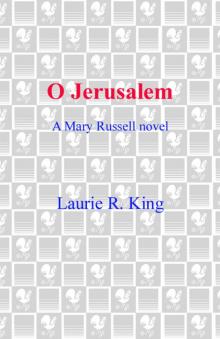 O Jerusalem
O Jerusalem Beekeeping for Beginners
Beekeeping for Beginners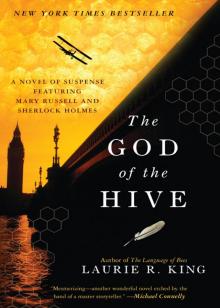 The God of the Hive
The God of the Hive The Language of Bees
The Language of Bees Night Work
Night Work Justice Hall
Justice Hall The Murder of Mary Russell
The Murder of Mary Russell Lockdown
Lockdown To Play the Fool
To Play the Fool Locked Rooms
Locked Rooms Island of the Mad
Island of the Mad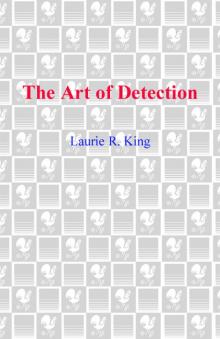 The Art of Detection
The Art of Detection The Mary Russell Series Books 1-4
The Mary Russell Series Books 1-4 The Beekeeper's Apprentice
The Beekeeper's Apprentice For the Sake of the Game
For the Sake of the Game A Darker Place
A Darker Place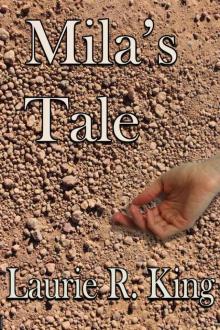 Mila's Tale
Mila's Tale Mrs Hudson's Case
Mrs Hudson's Case With Child
With Child The Marriage of Mary Russell
The Marriage of Mary Russell The Mary Russell Companion
The Mary Russell Companion Hellbender
Hellbender Castle Shade
Castle Shade The Bones of Paris
The Bones of Paris Riviera Gold
Riviera Gold A Grave Talent
A Grave Talent Pirate King
Pirate King Dreaming Spies
Dreaming Spies Folly
Folly Touchstone
Touchstone The Game
The Game The Mary Russell Series Books 1-4: The Beekeeper's Apprentice; A Monstrous Regiment of Women; A Letter of Mary; The Moor
The Mary Russell Series Books 1-4: The Beekeeper's Apprentice; A Monstrous Regiment of Women; A Letter of Mary; The Moor The Moor mr-4
The Moor mr-4 The Birth of a new moon
The Birth of a new moon With Child km-3
With Child km-3 A Letter of Mary mr-3
A Letter of Mary mr-3 Justice Hall mr-6
Justice Hall mr-6 Pirate King: A novel of suspense featuring Mary Russell and Sherlock Holmes
Pirate King: A novel of suspense featuring Mary Russell and Sherlock Holmes Pirate King: A novel of suspense featuring Mary Russell and Sherlock Holmes mr-11
Pirate King: A novel of suspense featuring Mary Russell and Sherlock Holmes mr-11 Beekeeping for Beginners (Short Story)
Beekeeping for Beginners (Short Story)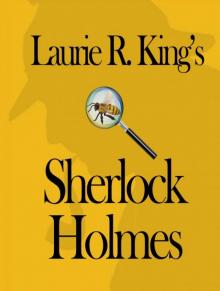 Laurie R. King's Sherlock Holmes
Laurie R. King's Sherlock Holmes Echoes of Sherlock Holmes
Echoes of Sherlock Holmes A Study in Sherlock
A Study in Sherlock The Game mr-7
The Game mr-7 Garment of Shadows: A Novel of Suspense Featuring Mary Russell and Sherlock Holmes
Garment of Shadows: A Novel of Suspense Featuring Mary Russell and Sherlock Holmes Dreaming Spies: A novel of suspense featuring Mary Russell and Sherlock Holmes
Dreaming Spies: A novel of suspense featuring Mary Russell and Sherlock Holmes Night Work km-4
Night Work km-4 Mary Russell's War
Mary Russell's War To Play the Fool km-2
To Play the Fool km-2 A Monstrous Regiment of Women mr-2
A Monstrous Regiment of Women mr-2 O Jerusalem mr-5
O Jerusalem mr-5 A Grave Talent km-1
A Grave Talent km-1